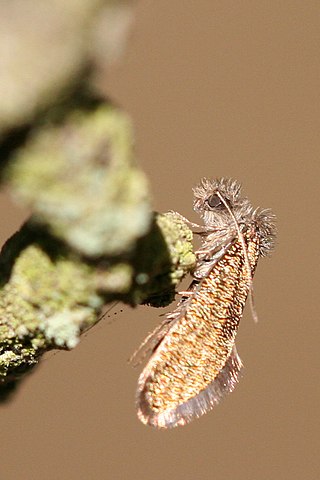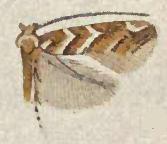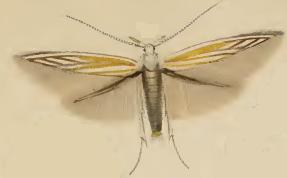
Dyseriocrania subpurpurella is a diurnal moth from the family Eriocraniidae, found in most of Europe. The moth was first named by the English entomologist, Adrian Hardy Haworth in 1828.

Dyseriocrania griseocapitella is a moth of the family Eriocraniidae. It is found from Nova Scotia to Florida, west to Illinois and Mississippi.

Stigmella alnetella is a moth of the family Nepticulidae. It is found in all of Europe, except the Balkan Peninsula.

Stigmella ruficapitella is a moth of the family Nepticulidae. It is found in northern and central Europe. It is mostly absent in the Mediterranean region, with the exception of Mount Olympus in Greece and Trieste. It has recently been recorded from Russia and Bosnia.

Phyllonorycter roboris is a moth of the family Gracillariidae. It is found in all of Europe.

The European oak leaf-miner or Zeller's midget is a moth of the family Gracillariidae. It is found in Europe south of the line running from Ireland, through Great Britain, Denmark to Ukraine. It is also found in Macaronesia. It is an introduced species in New Zealand and Australia.
Caloptilia leucapennella is a moth of the family Gracillariidae. It is known from all of Europe, except the Balkan Peninsula.

Euspilapteryx auroguttella is a moth of the family Gracillariidae. It is known from all of Europe.

Cameraria cincinnatiella is a moth of the family Gracillariidae. It is known from Ontario and Quebec in Canada, and the United States.

Coleophora currucipennella is a moth of the family Coleophoridae found in Europe. It was first described by Philipp Christoph Zeller in 1839.

Argyroploce arbutella is a moth of the family Tortricidae. It is found in most of Europe, from Fennoscandia and northern Russia to the Pyrenees, Sardinia, Italy and Bulgaria and from Ireland to Poland and Romania.

Coptotriche marginea is a moth of the family Tischeriidae, found in most of Europe. It was named by the English botanist, carcinologist and entomologist, Adrian Hardy Haworth in 1828, from a specimen found in England. The larvae mine the leaves of brambles (Rubus) species.

Bucculatrix ulmella is a moth of the family Bucculatricidae. It is found in most of Europe, except the Iberian Peninsula, Slovenia and Bulgaria. It was first described in 1848 by Philipp Christoph Zeller.
Eriocraniella aurosparsella is a moth of the family Eriocraniidae. It was described by Thomas de Grey in 1880. It is found from southern Oregon south through the coastal ranges of California to Santa Clara County and Santa Cruz Island.
Eriocraniella xanthocara is a moth of the family Eriocraniidae. It was described by Davis in 1978. It is found in California.
Eriocraniella falcata is a moth of the family Eriocraniidae. It was described by Davis in 1978. It is found in the Coast Ranges of central California.
Eriocraniella mediabulla is a moth of the family Eriocraniidae. It was described by Davis and Faeth in 1986. It is found in northern Georgia, northern Florida, southern Louisiana, north-eastern Texas, and North Carolina.

Argyresthia oreasella, the cherry shoot borer moth, is a moth of the family Yponomeutidae. It is found in North America, including New York, Michigan, Idaho, Missouri, Colorado, New Mexico, California, Quebec, Alberta and Saskatchewan.
Antispila orbiculella is a moth of the family Heliozelidae. It was described by Kuroko in 1961. It is found in Japan.
Elachista enitescens is a moth of the family Elachistidae. It is found in the United States, where it has been recorded from Ohio and Maine.








